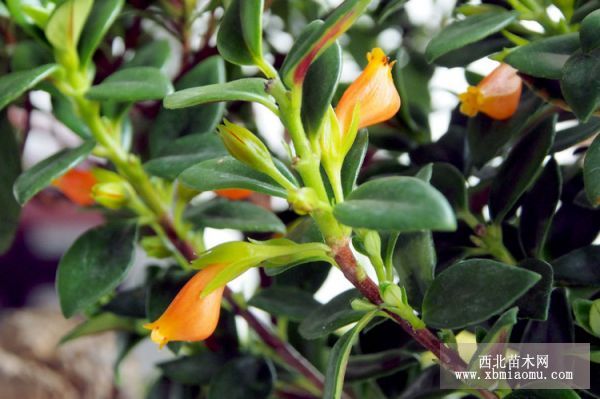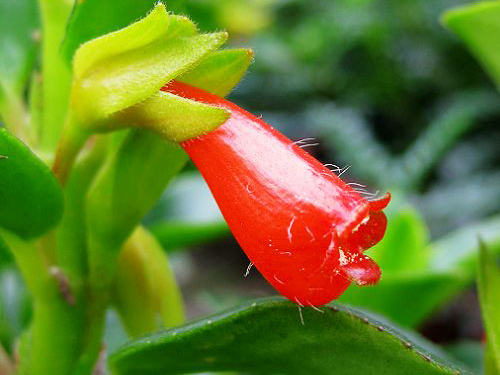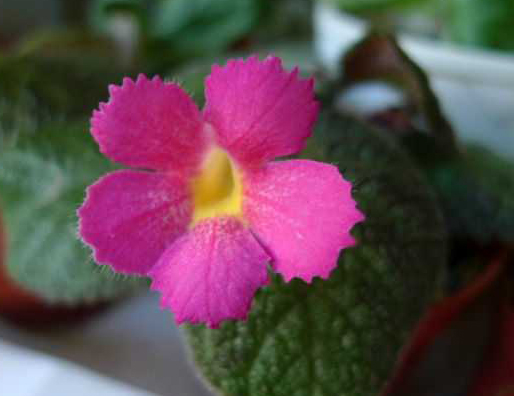Under what conditions will the lobular goldfish flower be colorful?
Small leaf goldfish flowers are perennial herbs or evergreen plants. The leaves are very small like buttons. Stems slender and drooping. Flowers solitary in leaf axils. Corolla scarlet, throat yellow.
(1)Sexual preference for warm, humid and bright environments. Spring, summer, autumn three seasons can be placed indoors with bright scattered light, budding after moving to the light is more abundant near the south-facing windowsill. In winter, it is placed indoors in a place with sufficient light. If long-term put dim light place culture, then thin tendrils weak, leaves easy to fall off, flowers less and pale color. The suitable temperature for growth is 18~22 degrees Celsius, and the room temperature during winter dormancy should be kept at about 15 degrees Celsius. If the temperature is below 10 degrees Celsius for a long time, it is easy to cause the leaves to fall off.
(2)During the growth period, thin cake fertilizer water was applied once every 2 weeks. Pot soil needs to be kept moist and attention should be paid to spraying water on the stems and leaves frequently to improve the air humidity. At the end of autumn and early winter flower bud differentiation period, it is necessary to reduce watering appropriately to facilitate flower bud formation. Winter has a short dormancy period, during which watering should be controlled to make the pot soil properly dry.
(3)Spring flowers after timely pruning, can promote its branching, plant shape more plump, and the number of flowers. Otherwise, the tendrils are slender, the branches are few, and the flowers bloom only at the top of the hanging stems. - After flowering, the pot is changed every other year. The pot soil is mainly decayed leaf soil or peat soil. 1/5 river sand is added, and a small amount of bone meal is added as base fertilizer.

Small goldfish flower suitable for indoor culture. Spring, summer and autumn three seasons indoor bright scattered light place, after budding to move to the light is more abundant near the south window. In winter, it should also be placed in a place with sufficient light. If it is cultivated in a dark place for a long time, the stem is slender and weak, the leaves are easy to fall off, and the flowers are few or not flowering. The growth season requires air humidity above 75%, too dry leaves easy to fall off, and affect flowering. Therefore, in addition to dormancy period, other periods need to keep the basin soil moist and often spray water on the stems and leaves to improve the air humidity. However, in the flower bud differentiation period in late autumn and early winter, it is necessary to reduce watering appropriately to facilitate flower bud differentiation. The optimum temperature for growth is 18℃ ~ 22℃, and the optimum temperature for dormancy is 14℃ ~ 16℃. If the temperature drops below 10℃, the leaf color is easy to turn yellow and appear mottled and debud. The plants usually enter dormancy between December and January. During this period, lower temperature and controlled watering should be given, but higher air humidity is still needed to make them bloom in the following spring. Spray should be suspended from bud development to flowering. Spring, autumn season can be every 7-10 days 1 time thin liquid fertilizer. In autumn, nitrogen fertilizer should be applied mainly to promote leafy stems. After spring, phosphorus and potassium fertilizer should be applied appropriately to facilitate colorful flowers. Pay attention to pruning in time after the flower withers. Pruning not only helps to promote branching, make the plant shape more plump, but also the flower position is moderate, thus improving the ornamental value. Otherwise, the tendrils are slender; only the top of the hanging stem has flowers, which is unsightly. Generally every 1 year after the flowers for-second pot. Basin soil to peat soil, land, river sand equal mix preparation, plus a small amount of bone meal or cake fertilizer as a base fertilizer is appropriate. Breeding lobular goldfish flowers, multi-cutting method, can be carried out throughout the year, but after the best flowers, specific methods see this book 44 Q. How to raise goldfish
How to raise goldfish
Goldfish Flower-Culture Method
Columnea gloriosa
[Other names] Colon flower, string goldfish, lobular goldfish flower, whale flower, button whale flower, lobular goldfish flower, goldfish spider orchid, kangaroo spider orchid, kangaroo flower
[Classification] Seed plants, angiosperms, dicotyledons, Scrophulariales, Gesneriaceae, goldfish flowers are convolvulaceae
Goldfish flower
Propagation can be used top branch cuttage or stem cutting method. It can be carried out all year round, and it is best to carry out indoors after flowering. Cut annual branches about 10~15cm, keep 3-4 leaves, remove the base number of leaflets, insert into sand. Cover with glass or plastic film, temperature control at 20℃, and maintain a high air humidity, about 3 to 4 weeks can take root. Two months after survival began to pick the heart, promote more branches, in order to more flowers, and then can be planted on the pot. Seedlings do not flower in the first year, and red flowers are spat out between leaf axils at the tip of pendants in the second and third years. Goldfish flower available seeding, ramets and cuttings propagation. Because the seed is not easy to obtain, many do not use seeding propagation, generally commonly used cutting propagation method. In spring and autumn, about 10 cm long (3-4 nodes) branches are cut and inserted into river sand or vermiculite cultivation beds to maintain high humidity. Rooting can take place at 20-25℃ for about one month; after rooting and survival, management should be strengthened to promote the growth of new branches, and topping should be carried out to promote branching. After 1-2 months, it can be planted in pots. Goldfish potted requirements matrix rich in humus, loose, good drainage, commonly used peat soil, pearlite and vermiculite equal mix, and make the soil leaves acidic, in order to facilitate growth. Liquid fertilizer should be applied every 1-2 weeks during growth period, and phosphorus and potassium fertilizer should be added during growth and flowering period. Winter has a short dormancy period, during which less watering can be done to keep the pot soil properly dry; winter (i.e. flowering period), more watering can be done properly; there should be sufficient moisture during the growth period, the pot soil must always be kept wet, and try to improve the air humidity. High temperature and humidity easily cause soft rot and death of stems and branches. If this happens, cut off the soft rot in time. Goldfish flowers prefer bright indirect light environment, so in summer when the light is too strong to shade (50% shade); in order to promote the formation of flower buds, autumn to give sunlight, and keep the pot soil slightly dry; winter dormancy best placed in a dry environment, promote flower bud differentiation; winter before flowering can be appropriately increased light, indoor must be moved to the brightest window, to ensure vigorous growth and flowering. Goldfish flowers dense branches and leaves, stems and vines hanging natural; flowering peak of a larger plant can flower more than 100 at the same time, and flowers big color Yan, quite spectacular, so it is very ideal shade-loving hanging leaves and flowers plants. It is suitable for greenhouse and indoor garden as epiphytic potted plants, but also as a family hanging appreciation.
Goldfish Flower-Cultivation Techniques
Goldfish flower
Suitable for small and medium-sized potted plants or indoor suspension, corridor green decoration. Its cultivation characteristics are as follows: 1. Substrate soil mixed with moldy leaf soil, manure and sand in the ratio of 3:1:1, pH value of 6 to 6.5. Thin compound fertilizer solution is applied every month, and phosphorus and potassium fertilizer solution is applied once every half month two months before flowering. Change pots every other year. 2. The suitable temperature for growth is 16℃ to 28℃. When it is above 30℃, it is necessary to strengthen shade ventilation, otherwise it will appear defoliation phenomenon, and it will be maintained at least above 10℃ during winter. 3, Yin resistance, suitable for scattered light, avoid direct light. When the surface of the basin soil is dry, water can be poured through, and water can be sprayed regularly to the leaves and around the plants to enhance air humidity and reduce watering in winter. 4. After flowering, all weak branches, top branches and excessively long drooping branches should be pruned. In winter, the withered flower stems should be cut off from the base and kept dry, which is conducive to the germination and growth of new flowers in the following spring. 5, mainly to cuttage propagation, can be cut with node branches, each section of about 8 cm, the upper leaves cut off half, the lower part of all cut off, maintain a semi-shady humid environment, about 30 days can take root on the pot. It can also be propagated by dividing plants, in early spring or late autumn, with 1 to 2 terminal buds per clump and 2 to 3 plants per potted plant.
Goldfish Flower-Cultivation Management
Goldfish flower
Goldfish flower is epiphyte, culture medium can be used peat, pearlite, vermiculite equal mixture; or with peat moss, fern root, bark block and other materials, with porous flowerpot cultivation, in order to facilitate ventilation and good drainage. Indoor cultivation should be placed in a place where there is no direct sunlight all day, and can be moved to a place with sufficient sunlight before flowering. Goldfish flower is sensitive to low temperature, the temperature dropped to 10℃ below the leaf color yellow, mottled and fall off. Avoid summer heat, summer should still be placed indoors, pay attention to ventilation shade, often keep moist. Watering should be in line with the principle of "rather wet not dry", dry season leaves evaporation exuberant, should increase the number of watering, but be careful not to be too wet. From December to January of the following year, the plants enter the dormancy period. In order to make the flowers bloom luxuriantly in the coming year, the room temperature should be controlled between 14~16℃, and the water supply should be controlled to keep it dry. Growing season to pay attention to maintain a high humidity environment, can be used spray humidification, or often spray with water pots and surrounding ground. But when the buds are colored or into flowering, spraying should be stopped, otherwise the leaves will produce yellow spots. Fertilize every 1 ~2 weeks during vigorous growth period, and add more phosphorus to facilitate the formation of flower buds. Goldfish flower more resistant to pruning, long not pruning flowering parts upward, can be in flower after its main branches for light truncation, so that the formation of more branches. Goldfish flowers can be used cutting methods to reproduce: cut new branches about 5-6 cm, inserted in the river sand seedbed can be. Cuttage survival seedlings, planted in humus-based culture soil, 3-4 plants per pot, for future modeling under the foundation. If you want to promote branching, you can pick it at the growth stage. Goldfish flowers in spring, summer, autumn three seasons to pour more water, often with water spraying around the ground, avoid sprinkling water on the leaves. In summer, when it is hot, it is best to put the flowerpot in a shallow dish of water. All these measures can avoid falling leaves caused by dry air. Goldfish flowers in winter and spring before flowering should also be properly watered, so that flowers can fully bloom, colorful. Goldfish flowers in addition to winter to have more adequate sunlight, the rest of the season to more shade, spring, summer, autumn should cover 60% to 70% of the sun, or hanging in outdoor shade, or large shade, ventilated place, more scattered light without direct sunlight. Such an environment is suitable for its growth. Goldfish flowers in winter before flowering, should be appropriate to enhance the light, so as to make its flowers colorful. In the family basin hanging cultivation, can be placed in a bright, ventilated indoor, can be placed all the year round, viewing. Goldfish flowers in flowering do not fertilize, after flowering should be trimmed plastic, and more nitrogenous fertilizer. During the growth period, organic thin fertilizer solution should be applied once every 1~2 weeks to make it grow vigorously; phosphorus fertilizer should be added before flowering to make it more pregnant buds and flowers, and enhance its ornamental effect.
In autumn, nitrogen fertilizer should be applied mainly to promote leafy stems. After spring, phosphorus and potassium fertilizer should be applied appropriately to facilitate colorful flowers. Pay attention to pruning in time after the flower withers. Pruning not only helps to promote branching, make the plant shape more plump, but also the flower position is moderate, thus improving the ornamental value. Otherwise, the tendrils are slender; only the top of the hanging stem has flowers, which is unsightly. Generally every 1 year after the flower for-second pot. Basin soil to peat soil, land, river sand equal mix preparation, plus a small amount of bone meal or cake fertilizer as a base fertilizer is appropriate. Propagation lobular goldfish flower, multi-cutting method, can be carried out throughout the year, but after flowering the best.
- Prev

What are the key points for the maintenance of red goldfish flowers?
Dahong goldfish flower is a perennial evergreen herbaceous vine. Its stem branches are slender and soft and drooping, and are easy to branch. Flowers solitary, long tube-shaped lip-shaped flowers resemble goldfish, orange-red with yellowish halo. Bloom in spring and summer. If the temperature is right, it can bloom all the year round. Bright red goldfish flowers like to be warm and humid, and avoid strong light in summer.
- Next

What should be paid attention to in the maintenance of Xi Yinhua?
Xi Yinhua is famous for its red paulownia grass. Flowers are solitary in the axils of leaves, scarlet, and bloom in summer. Common varieties are emerald queen, leaves are dark green, midrib silver-white; copper-green shade flowers, leaves are copper-green, leaf edges are light red; chocolate flowers, silver-white main veins, silver-light shade flowers, flowers and leaves, etc.
Related
- Fuxing push coffee new agricultural production and marketing class: lack of small-scale processing plants
- Jujube rice field leisure farm deep ploughing Yilan for five years to create a space for organic food and play
- Nongyu Farm-A trial of organic papaya for brave women with advanced technology
- Four points for attention in the prevention and control of diseases and insect pests of edible fungi
- How to add nutrient solution to Edible Fungi
- Is there any good way to control edible fungus mites?
- Open Inoculation Technology of Edible Fungi
- Is there any clever way to use fertilizer for edible fungus in winter?
- What agents are used to kill the pathogens of edible fungi in the mushroom shed?
- Rapid drying of Edible Fungi

